Sainsbury's Marketing Strategy and Environment Analysis Report
VerifiedAdded on 2022/12/23
|9
|2369
|82
Report
AI Summary
This report provides a detailed analysis of Sainsbury's marketing strategies and environment. It begins with an introduction to the company, followed by an overview of the current marketing environment using PESTLE analysis, examining political, economic, social, technological, legal, and environmental factors. The report then delves into SWOT analysis, highlighting Sainsbury's strengths, weaknesses, opportunities, and threats. Porter's Five Forces model is used to analyze the competitive landscape. The Ansoff matrix is then applied to explore potential growth strategies, particularly product development. Finally, the report analyzes Sainsbury's positioning and targeting strategy using perception maps, segmentation techniques (demographic, behavioral, geographical, and physiological), and the 4Cs of effective positioning (customer, cost, convenience, and communication) to enhance its market value. The report concludes by summarizing the key findings and their implications for Sainsbury's future marketing efforts.
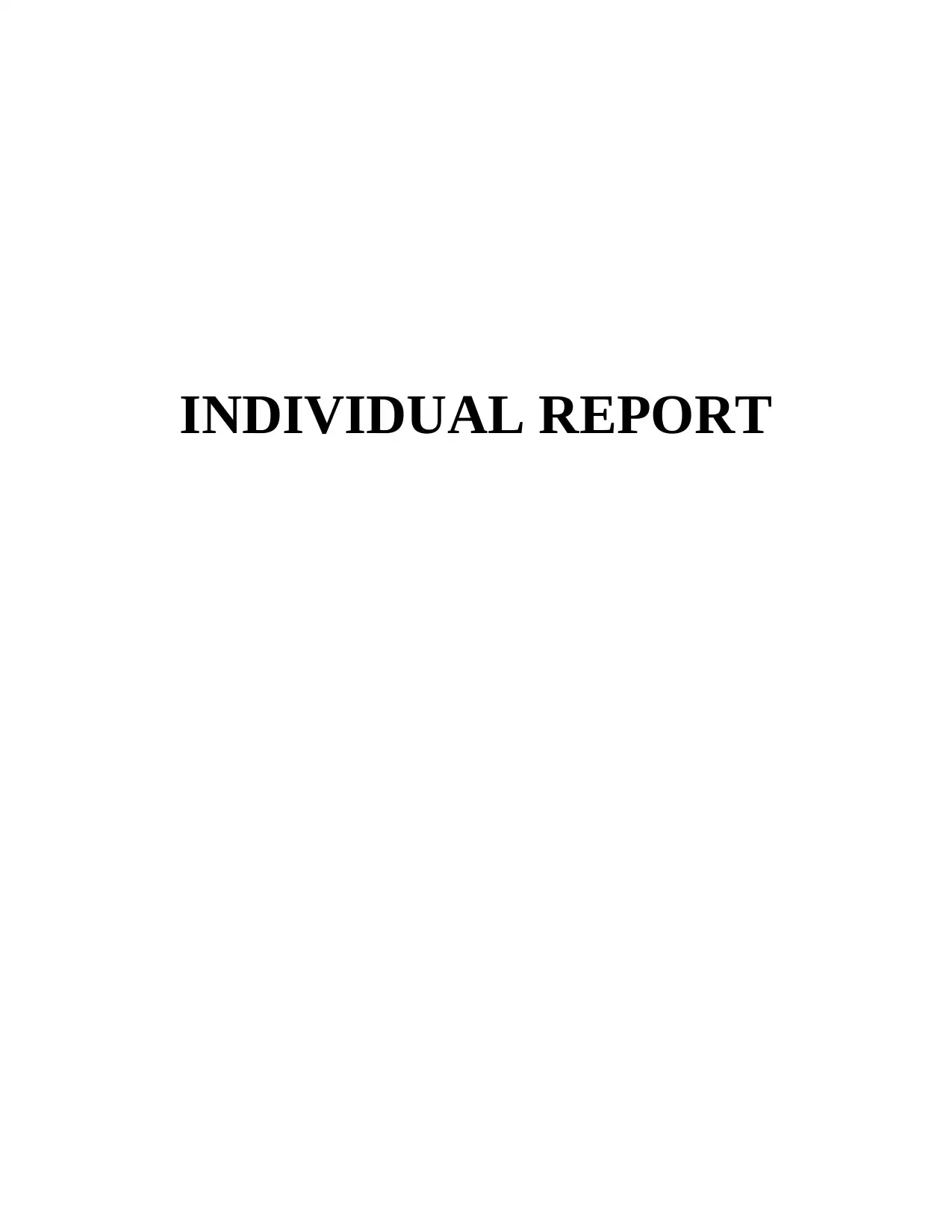
INDIVIDUAL REPORT
Paraphrase This Document
Need a fresh take? Get an instant paraphrase of this document with our AI Paraphraser
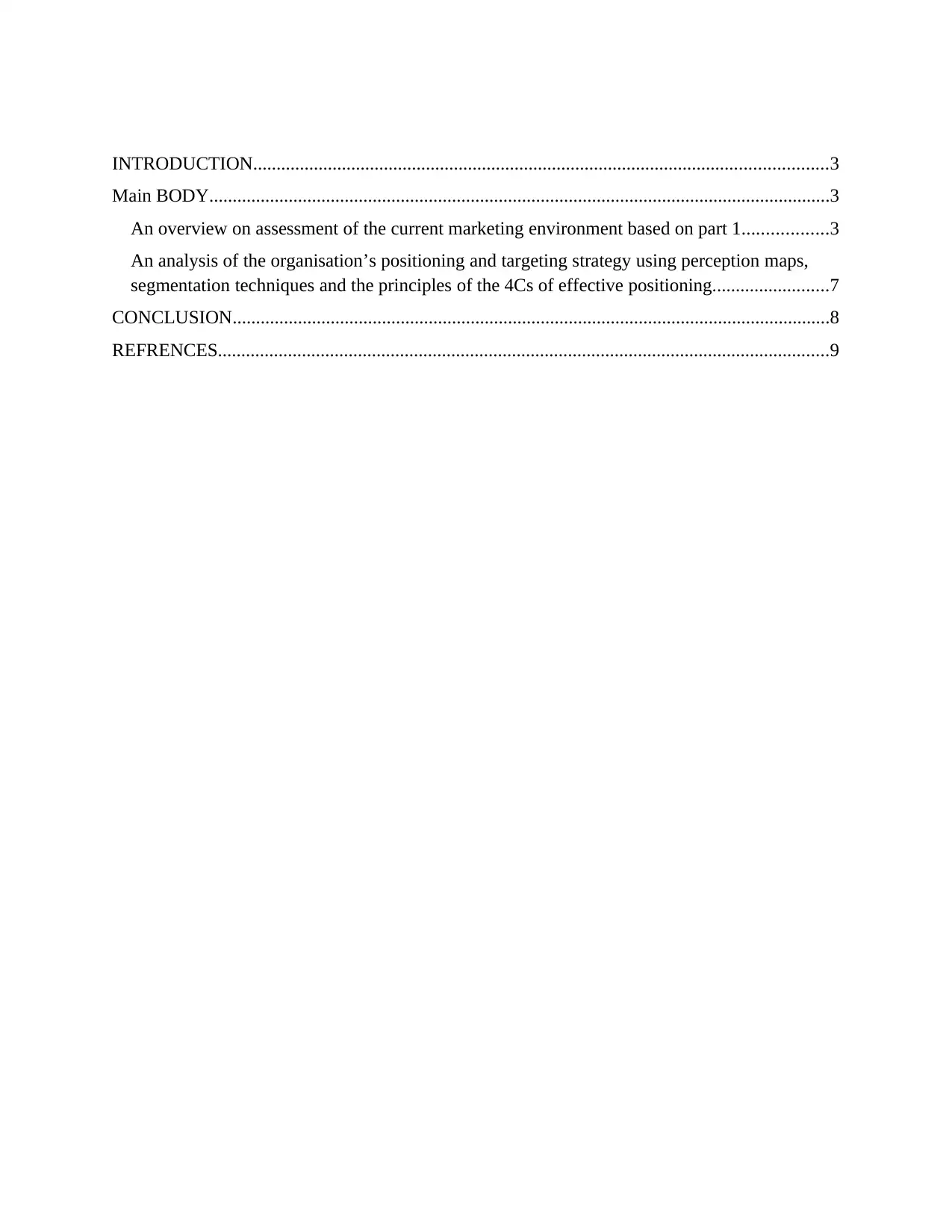
INTRODUCTION...........................................................................................................................3
Main BODY.....................................................................................................................................3
An overview on assessment of the current marketing environment based on part 1..................3
An analysis of the organisation’s positioning and targeting strategy using perception maps,
segmentation techniques and the principles of the 4Cs of effective positioning.........................7
CONCLUSION................................................................................................................................8
REFRENCES...................................................................................................................................9
Main BODY.....................................................................................................................................3
An overview on assessment of the current marketing environment based on part 1..................3
An analysis of the organisation’s positioning and targeting strategy using perception maps,
segmentation techniques and the principles of the 4Cs of effective positioning.........................7
CONCLUSION................................................................................................................................8
REFRENCES...................................................................................................................................9
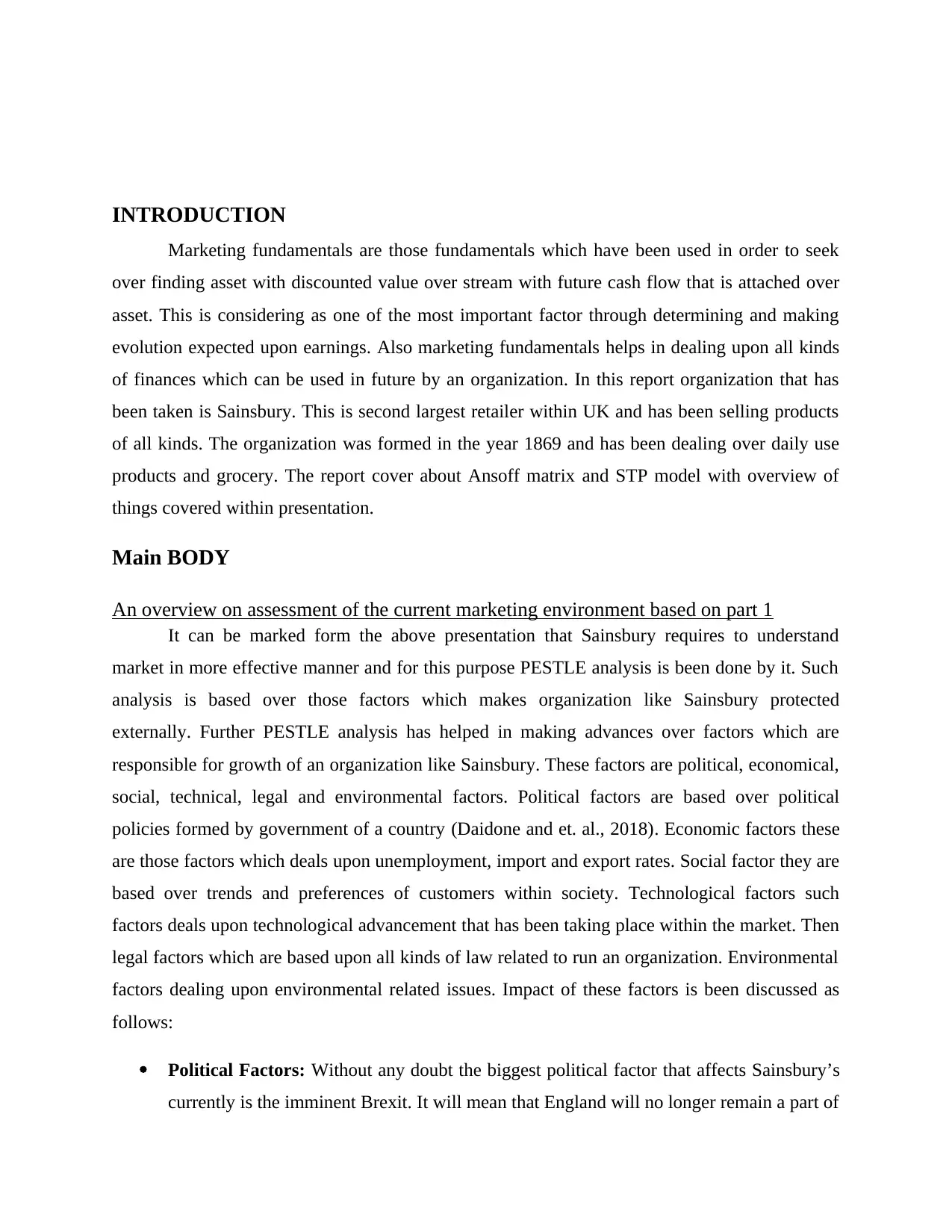
INTRODUCTION
Marketing fundamentals are those fundamentals which have been used in order to seek
over finding asset with discounted value over stream with future cash flow that is attached over
asset. This is considering as one of the most important factor through determining and making
evolution expected upon earnings. Also marketing fundamentals helps in dealing upon all kinds
of finances which can be used in future by an organization. In this report organization that has
been taken is Sainsbury. This is second largest retailer within UK and has been selling products
of all kinds. The organization was formed in the year 1869 and has been dealing over daily use
products and grocery. The report cover about Ansoff matrix and STP model with overview of
things covered within presentation.
Main BODY
An overview on assessment of the current marketing environment based on part 1
It can be marked form the above presentation that Sainsbury requires to understand
market in more effective manner and for this purpose PESTLE analysis is been done by it. Such
analysis is based over those factors which makes organization like Sainsbury protected
externally. Further PESTLE analysis has helped in making advances over factors which are
responsible for growth of an organization like Sainsbury. These factors are political, economical,
social, technical, legal and environmental factors. Political factors are based over political
policies formed by government of a country (Daidone and et. al., 2018). Economic factors these
are those factors which deals upon unemployment, import and export rates. Social factor they are
based over trends and preferences of customers within society. Technological factors such
factors deals upon technological advancement that has been taking place within the market. Then
legal factors which are based upon all kinds of law related to run an organization. Environmental
factors dealing upon environmental related issues. Impact of these factors is been discussed as
follows:
Political Factors: Without any doubt the biggest political factor that affects Sainsbury’s
currently is the imminent Brexit. It will mean that England will no longer remain a part of
Marketing fundamentals are those fundamentals which have been used in order to seek
over finding asset with discounted value over stream with future cash flow that is attached over
asset. This is considering as one of the most important factor through determining and making
evolution expected upon earnings. Also marketing fundamentals helps in dealing upon all kinds
of finances which can be used in future by an organization. In this report organization that has
been taken is Sainsbury. This is second largest retailer within UK and has been selling products
of all kinds. The organization was formed in the year 1869 and has been dealing over daily use
products and grocery. The report cover about Ansoff matrix and STP model with overview of
things covered within presentation.
Main BODY
An overview on assessment of the current marketing environment based on part 1
It can be marked form the above presentation that Sainsbury requires to understand
market in more effective manner and for this purpose PESTLE analysis is been done by it. Such
analysis is based over those factors which makes organization like Sainsbury protected
externally. Further PESTLE analysis has helped in making advances over factors which are
responsible for growth of an organization like Sainsbury. These factors are political, economical,
social, technical, legal and environmental factors. Political factors are based over political
policies formed by government of a country (Daidone and et. al., 2018). Economic factors these
are those factors which deals upon unemployment, import and export rates. Social factor they are
based over trends and preferences of customers within society. Technological factors such
factors deals upon technological advancement that has been taking place within the market. Then
legal factors which are based upon all kinds of law related to run an organization. Environmental
factors dealing upon environmental related issues. Impact of these factors is been discussed as
follows:
Political Factors: Without any doubt the biggest political factor that affects Sainsbury’s
currently is the imminent Brexit. It will mean that England will no longer remain a part of
⊘ This is a preview!⊘
Do you want full access?
Subscribe today to unlock all pages.

Trusted by 1+ million students worldwide
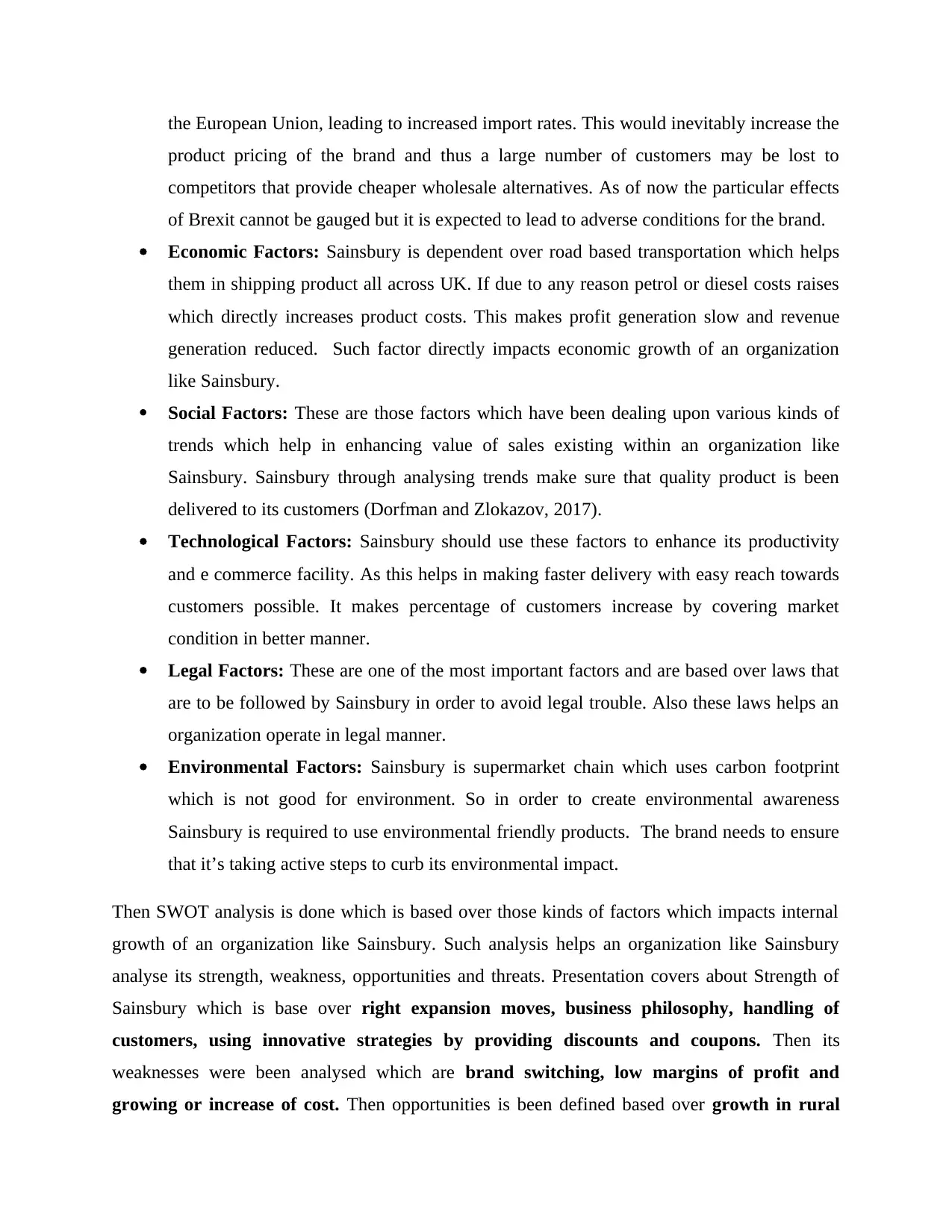
the European Union, leading to increased import rates. This would inevitably increase the
product pricing of the brand and thus a large number of customers may be lost to
competitors that provide cheaper wholesale alternatives. As of now the particular effects
of Brexit cannot be gauged but it is expected to lead to adverse conditions for the brand.
Economic Factors: Sainsbury is dependent over road based transportation which helps
them in shipping product all across UK. If due to any reason petrol or diesel costs raises
which directly increases product costs. This makes profit generation slow and revenue
generation reduced. Such factor directly impacts economic growth of an organization
like Sainsbury.
Social Factors: These are those factors which have been dealing upon various kinds of
trends which help in enhancing value of sales existing within an organization like
Sainsbury. Sainsbury through analysing trends make sure that quality product is been
delivered to its customers (Dorfman and Zlokazov, 2017).
Technological Factors: Sainsbury should use these factors to enhance its productivity
and e commerce facility. As this helps in making faster delivery with easy reach towards
customers possible. It makes percentage of customers increase by covering market
condition in better manner.
Legal Factors: These are one of the most important factors and are based over laws that
are to be followed by Sainsbury in order to avoid legal trouble. Also these laws helps an
organization operate in legal manner.
Environmental Factors: Sainsbury is supermarket chain which uses carbon footprint
which is not good for environment. So in order to create environmental awareness
Sainsbury is required to use environmental friendly products. The brand needs to ensure
that it’s taking active steps to curb its environmental impact.
Then SWOT analysis is done which is based over those kinds of factors which impacts internal
growth of an organization like Sainsbury. Such analysis helps an organization like Sainsbury
analyse its strength, weakness, opportunities and threats. Presentation covers about Strength of
Sainsbury which is base over right expansion moves, business philosophy, handling of
customers, using innovative strategies by providing discounts and coupons. Then its
weaknesses were been analysed which are brand switching, low margins of profit and
growing or increase of cost. Then opportunities is been defined based over growth in rural
product pricing of the brand and thus a large number of customers may be lost to
competitors that provide cheaper wholesale alternatives. As of now the particular effects
of Brexit cannot be gauged but it is expected to lead to adverse conditions for the brand.
Economic Factors: Sainsbury is dependent over road based transportation which helps
them in shipping product all across UK. If due to any reason petrol or diesel costs raises
which directly increases product costs. This makes profit generation slow and revenue
generation reduced. Such factor directly impacts economic growth of an organization
like Sainsbury.
Social Factors: These are those factors which have been dealing upon various kinds of
trends which help in enhancing value of sales existing within an organization like
Sainsbury. Sainsbury through analysing trends make sure that quality product is been
delivered to its customers (Dorfman and Zlokazov, 2017).
Technological Factors: Sainsbury should use these factors to enhance its productivity
and e commerce facility. As this helps in making faster delivery with easy reach towards
customers possible. It makes percentage of customers increase by covering market
condition in better manner.
Legal Factors: These are one of the most important factors and are based over laws that
are to be followed by Sainsbury in order to avoid legal trouble. Also these laws helps an
organization operate in legal manner.
Environmental Factors: Sainsbury is supermarket chain which uses carbon footprint
which is not good for environment. So in order to create environmental awareness
Sainsbury is required to use environmental friendly products. The brand needs to ensure
that it’s taking active steps to curb its environmental impact.
Then SWOT analysis is done which is based over those kinds of factors which impacts internal
growth of an organization like Sainsbury. Such analysis helps an organization like Sainsbury
analyse its strength, weakness, opportunities and threats. Presentation covers about Strength of
Sainsbury which is base over right expansion moves, business philosophy, handling of
customers, using innovative strategies by providing discounts and coupons. Then its
weaknesses were been analysed which are brand switching, low margins of profit and
growing or increase of cost. Then opportunities is been defined based over growth in rural
Paraphrase This Document
Need a fresh take? Get an instant paraphrase of this document with our AI Paraphraser
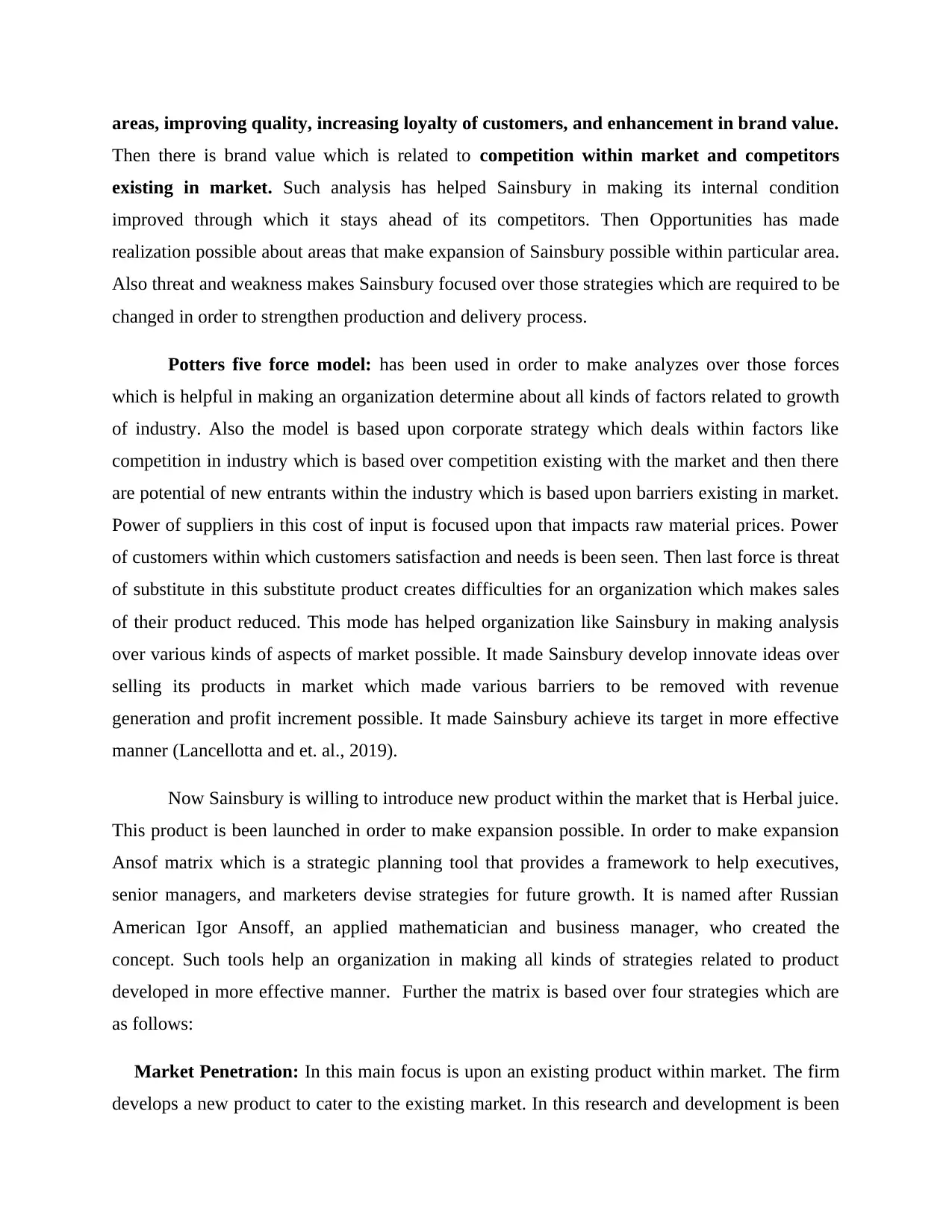
areas, improving quality, increasing loyalty of customers, and enhancement in brand value.
Then there is brand value which is related to competition within market and competitors
existing in market. Such analysis has helped Sainsbury in making its internal condition
improved through which it stays ahead of its competitors. Then Opportunities has made
realization possible about areas that make expansion of Sainsbury possible within particular area.
Also threat and weakness makes Sainsbury focused over those strategies which are required to be
changed in order to strengthen production and delivery process.
Potters five force model: has been used in order to make analyzes over those forces
which is helpful in making an organization determine about all kinds of factors related to growth
of industry. Also the model is based upon corporate strategy which deals within factors like
competition in industry which is based over competition existing with the market and then there
are potential of new entrants within the industry which is based upon barriers existing in market.
Power of suppliers in this cost of input is focused upon that impacts raw material prices. Power
of customers within which customers satisfaction and needs is been seen. Then last force is threat
of substitute in this substitute product creates difficulties for an organization which makes sales
of their product reduced. This mode has helped organization like Sainsbury in making analysis
over various kinds of aspects of market possible. It made Sainsbury develop innovate ideas over
selling its products in market which made various barriers to be removed with revenue
generation and profit increment possible. It made Sainsbury achieve its target in more effective
manner (Lancellotta and et. al., 2019).
Now Sainsbury is willing to introduce new product within the market that is Herbal juice.
This product is been launched in order to make expansion possible. In order to make expansion
Ansof matrix which is a strategic planning tool that provides a framework to help executives,
senior managers, and marketers devise strategies for future growth. It is named after Russian
American Igor Ansoff, an applied mathematician and business manager, who created the
concept. Such tools help an organization in making all kinds of strategies related to product
developed in more effective manner. Further the matrix is based over four strategies which are
as follows:
Market Penetration: In this main focus is upon an existing product within market. The firm
develops a new product to cater to the existing market. In this research and development is been
Then there is brand value which is related to competition within market and competitors
existing in market. Such analysis has helped Sainsbury in making its internal condition
improved through which it stays ahead of its competitors. Then Opportunities has made
realization possible about areas that make expansion of Sainsbury possible within particular area.
Also threat and weakness makes Sainsbury focused over those strategies which are required to be
changed in order to strengthen production and delivery process.
Potters five force model: has been used in order to make analyzes over those forces
which is helpful in making an organization determine about all kinds of factors related to growth
of industry. Also the model is based upon corporate strategy which deals within factors like
competition in industry which is based over competition existing with the market and then there
are potential of new entrants within the industry which is based upon barriers existing in market.
Power of suppliers in this cost of input is focused upon that impacts raw material prices. Power
of customers within which customers satisfaction and needs is been seen. Then last force is threat
of substitute in this substitute product creates difficulties for an organization which makes sales
of their product reduced. This mode has helped organization like Sainsbury in making analysis
over various kinds of aspects of market possible. It made Sainsbury develop innovate ideas over
selling its products in market which made various barriers to be removed with revenue
generation and profit increment possible. It made Sainsbury achieve its target in more effective
manner (Lancellotta and et. al., 2019).
Now Sainsbury is willing to introduce new product within the market that is Herbal juice.
This product is been launched in order to make expansion possible. In order to make expansion
Ansof matrix which is a strategic planning tool that provides a framework to help executives,
senior managers, and marketers devise strategies for future growth. It is named after Russian
American Igor Ansoff, an applied mathematician and business manager, who created the
concept. Such tools help an organization in making all kinds of strategies related to product
developed in more effective manner. Further the matrix is based over four strategies which are
as follows:
Market Penetration: In this main focus is upon an existing product within market. The firm
develops a new product to cater to the existing market. In this research and development is been
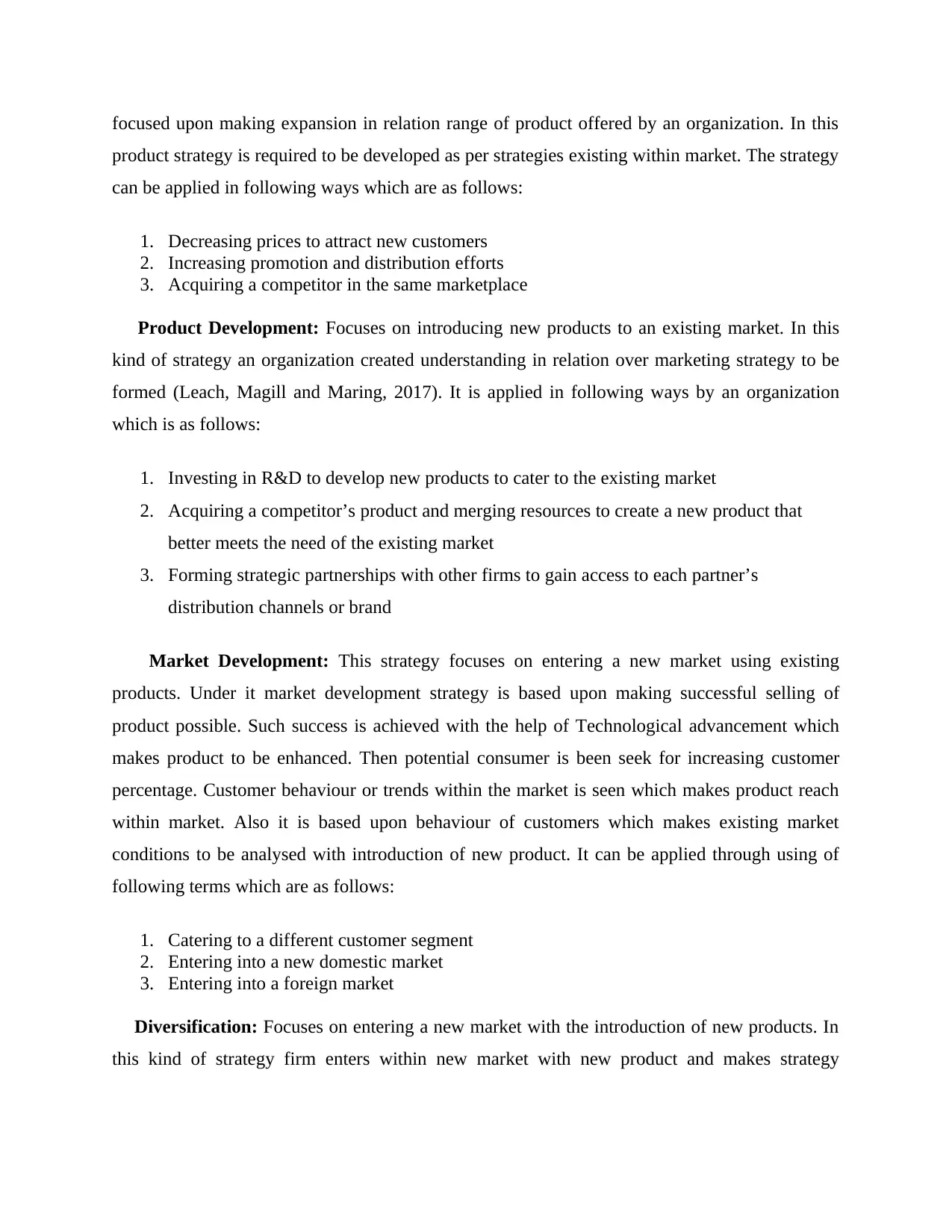
focused upon making expansion in relation range of product offered by an organization. In this
product strategy is required to be developed as per strategies existing within market. The strategy
can be applied in following ways which are as follows:
1. Decreasing prices to attract new customers
2. Increasing promotion and distribution efforts
3. Acquiring a competitor in the same marketplace
Product Development: Focuses on introducing new products to an existing market. In this
kind of strategy an organization created understanding in relation over marketing strategy to be
formed (Leach, Magill and Maring, 2017). It is applied in following ways by an organization
which is as follows:
1. Investing in R&D to develop new products to cater to the existing market
2. Acquiring a competitor’s product and merging resources to create a new product that
better meets the need of the existing market
3. Forming strategic partnerships with other firms to gain access to each partner’s
distribution channels or brand
Market Development: This strategy focuses on entering a new market using existing
products. Under it market development strategy is based upon making successful selling of
product possible. Such success is achieved with the help of Technological advancement which
makes product to be enhanced. Then potential consumer is been seek for increasing customer
percentage. Customer behaviour or trends within the market is seen which makes product reach
within market. Also it is based upon behaviour of customers which makes existing market
conditions to be analysed with introduction of new product. It can be applied through using of
following terms which are as follows:
1. Catering to a different customer segment
2. Entering into a new domestic market
3. Entering into a foreign market
Diversification: Focuses on entering a new market with the introduction of new products. In
this kind of strategy firm enters within new market with new product and makes strategy
product strategy is required to be developed as per strategies existing within market. The strategy
can be applied in following ways which are as follows:
1. Decreasing prices to attract new customers
2. Increasing promotion and distribution efforts
3. Acquiring a competitor in the same marketplace
Product Development: Focuses on introducing new products to an existing market. In this
kind of strategy an organization created understanding in relation over marketing strategy to be
formed (Leach, Magill and Maring, 2017). It is applied in following ways by an organization
which is as follows:
1. Investing in R&D to develop new products to cater to the existing market
2. Acquiring a competitor’s product and merging resources to create a new product that
better meets the need of the existing market
3. Forming strategic partnerships with other firms to gain access to each partner’s
distribution channels or brand
Market Development: This strategy focuses on entering a new market using existing
products. Under it market development strategy is based upon making successful selling of
product possible. Such success is achieved with the help of Technological advancement which
makes product to be enhanced. Then potential consumer is been seek for increasing customer
percentage. Customer behaviour or trends within the market is seen which makes product reach
within market. Also it is based upon behaviour of customers which makes existing market
conditions to be analysed with introduction of new product. It can be applied through using of
following terms which are as follows:
1. Catering to a different customer segment
2. Entering into a new domestic market
3. Entering into a foreign market
Diversification: Focuses on entering a new market with the introduction of new products. In
this kind of strategy firm enters within new market with new product and makes strategy
⊘ This is a preview!⊘
Do you want full access?
Subscribe today to unlock all pages.

Trusted by 1+ million students worldwide
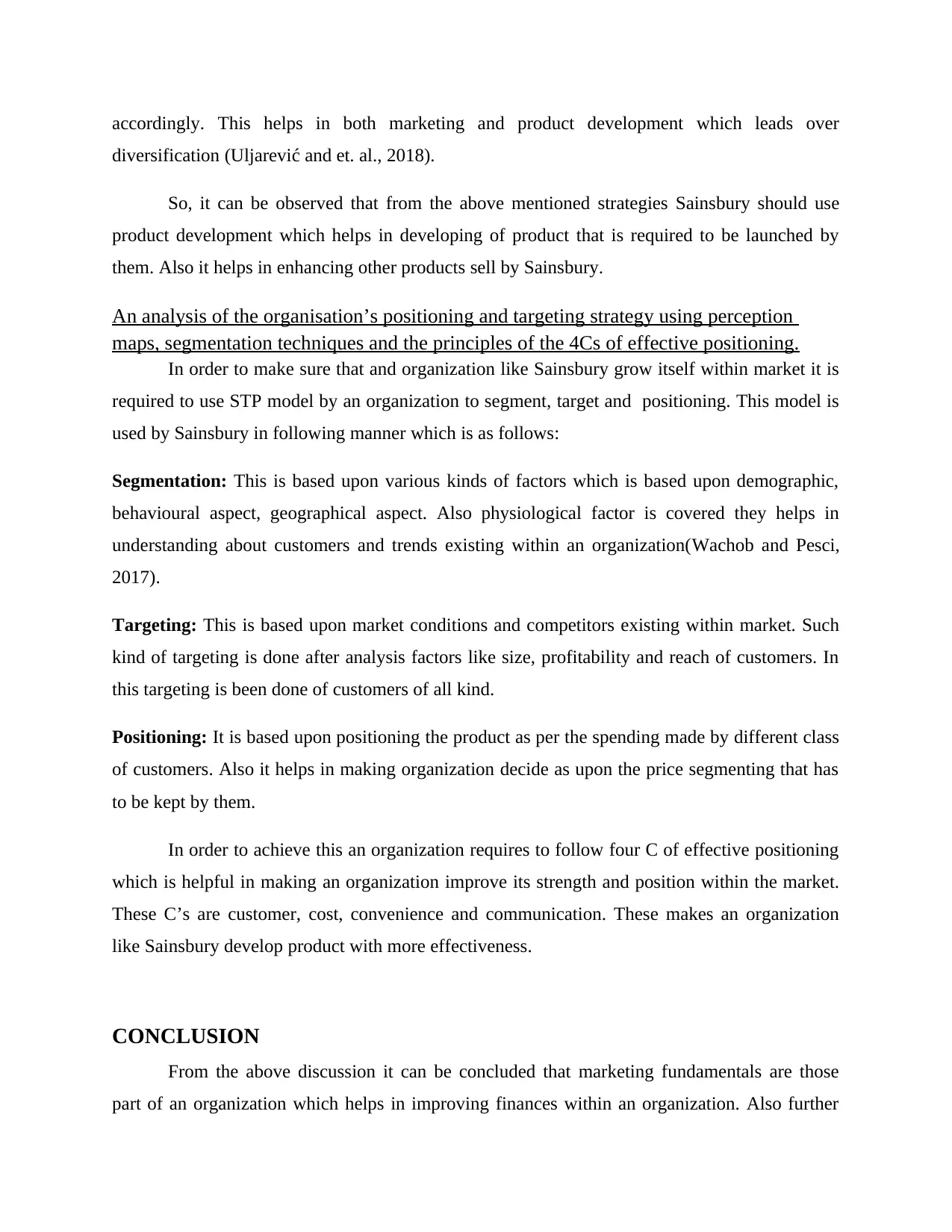
accordingly. This helps in both marketing and product development which leads over
diversification (Uljarević and et. al., 2018).
So, it can be observed that from the above mentioned strategies Sainsbury should use
product development which helps in developing of product that is required to be launched by
them. Also it helps in enhancing other products sell by Sainsbury.
An analysis of the organisation’s positioning and targeting strategy using perception
maps, segmentation techniques and the principles of the 4Cs of effective positioning.
In order to make sure that and organization like Sainsbury grow itself within market it is
required to use STP model by an organization to segment, target and positioning. This model is
used by Sainsbury in following manner which is as follows:
Segmentation: This is based upon various kinds of factors which is based upon demographic,
behavioural aspect, geographical aspect. Also physiological factor is covered they helps in
understanding about customers and trends existing within an organization(Wachob and Pesci,
2017).
Targeting: This is based upon market conditions and competitors existing within market. Such
kind of targeting is done after analysis factors like size, profitability and reach of customers. In
this targeting is been done of customers of all kind.
Positioning: It is based upon positioning the product as per the spending made by different class
of customers. Also it helps in making organization decide as upon the price segmenting that has
to be kept by them.
In order to achieve this an organization requires to follow four C of effective positioning
which is helpful in making an organization improve its strength and position within the market.
These C’s are customer, cost, convenience and communication. These makes an organization
like Sainsbury develop product with more effectiveness.
CONCLUSION
From the above discussion it can be concluded that marketing fundamentals are those
part of an organization which helps in improving finances within an organization. Also further
diversification (Uljarević and et. al., 2018).
So, it can be observed that from the above mentioned strategies Sainsbury should use
product development which helps in developing of product that is required to be launched by
them. Also it helps in enhancing other products sell by Sainsbury.
An analysis of the organisation’s positioning and targeting strategy using perception
maps, segmentation techniques and the principles of the 4Cs of effective positioning.
In order to make sure that and organization like Sainsbury grow itself within market it is
required to use STP model by an organization to segment, target and positioning. This model is
used by Sainsbury in following manner which is as follows:
Segmentation: This is based upon various kinds of factors which is based upon demographic,
behavioural aspect, geographical aspect. Also physiological factor is covered they helps in
understanding about customers and trends existing within an organization(Wachob and Pesci,
2017).
Targeting: This is based upon market conditions and competitors existing within market. Such
kind of targeting is done after analysis factors like size, profitability and reach of customers. In
this targeting is been done of customers of all kind.
Positioning: It is based upon positioning the product as per the spending made by different class
of customers. Also it helps in making organization decide as upon the price segmenting that has
to be kept by them.
In order to achieve this an organization requires to follow four C of effective positioning
which is helpful in making an organization improve its strength and position within the market.
These C’s are customer, cost, convenience and communication. These makes an organization
like Sainsbury develop product with more effectiveness.
CONCLUSION
From the above discussion it can be concluded that marketing fundamentals are those
part of an organization which helps in improving finances within an organization. Also further
Paraphrase This Document
Need a fresh take? Get an instant paraphrase of this document with our AI Paraphraser
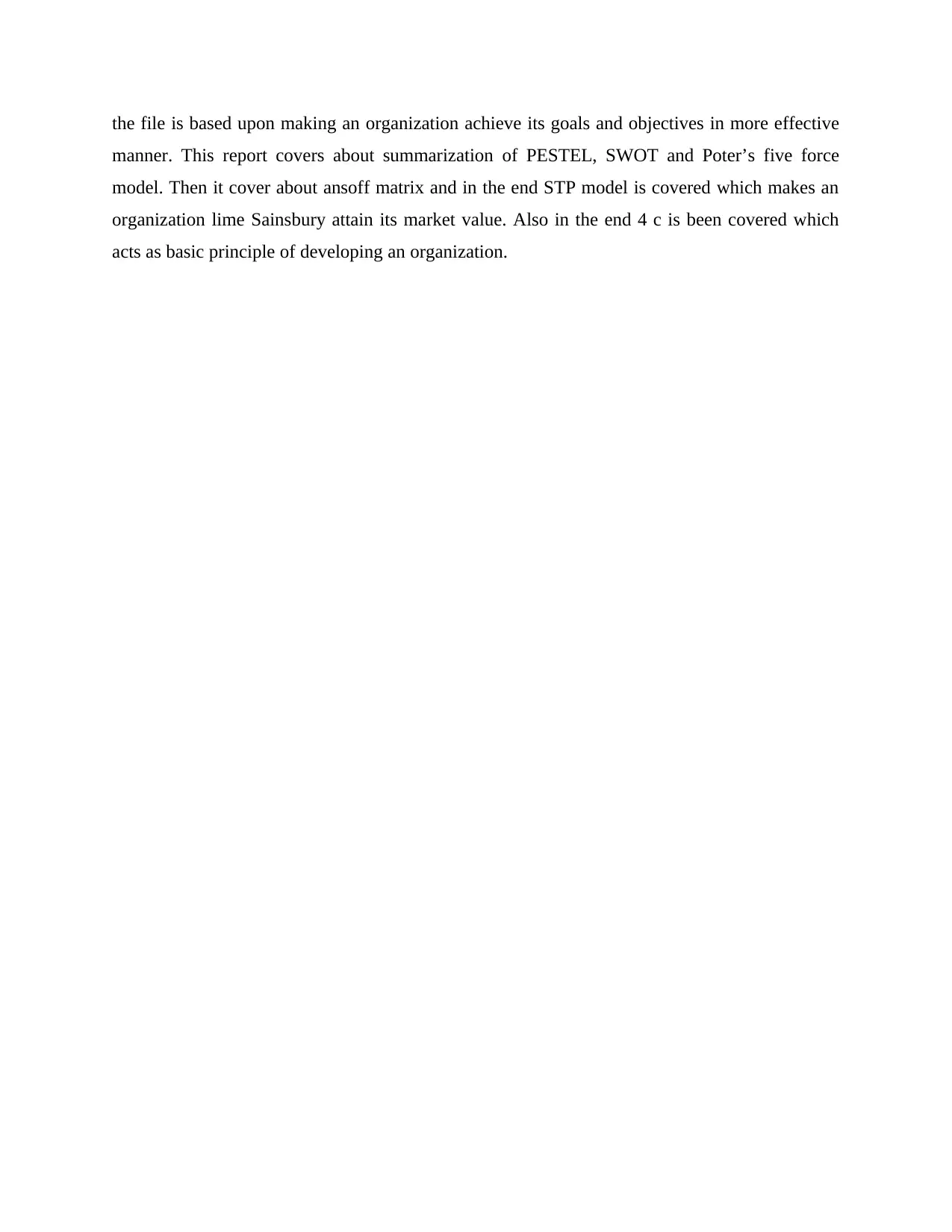
the file is based upon making an organization achieve its goals and objectives in more effective
manner. This report covers about summarization of PESTEL, SWOT and Poter’s five force
model. Then it cover about ansoff matrix and in the end STP model is covered which makes an
organization lime Sainsbury attain its market value. Also in the end 4 c is been covered which
acts as basic principle of developing an organization.
manner. This report covers about summarization of PESTEL, SWOT and Poter’s five force
model. Then it cover about ansoff matrix and in the end STP model is covered which makes an
organization lime Sainsbury attain its market value. Also in the end 4 c is been covered which
acts as basic principle of developing an organization.
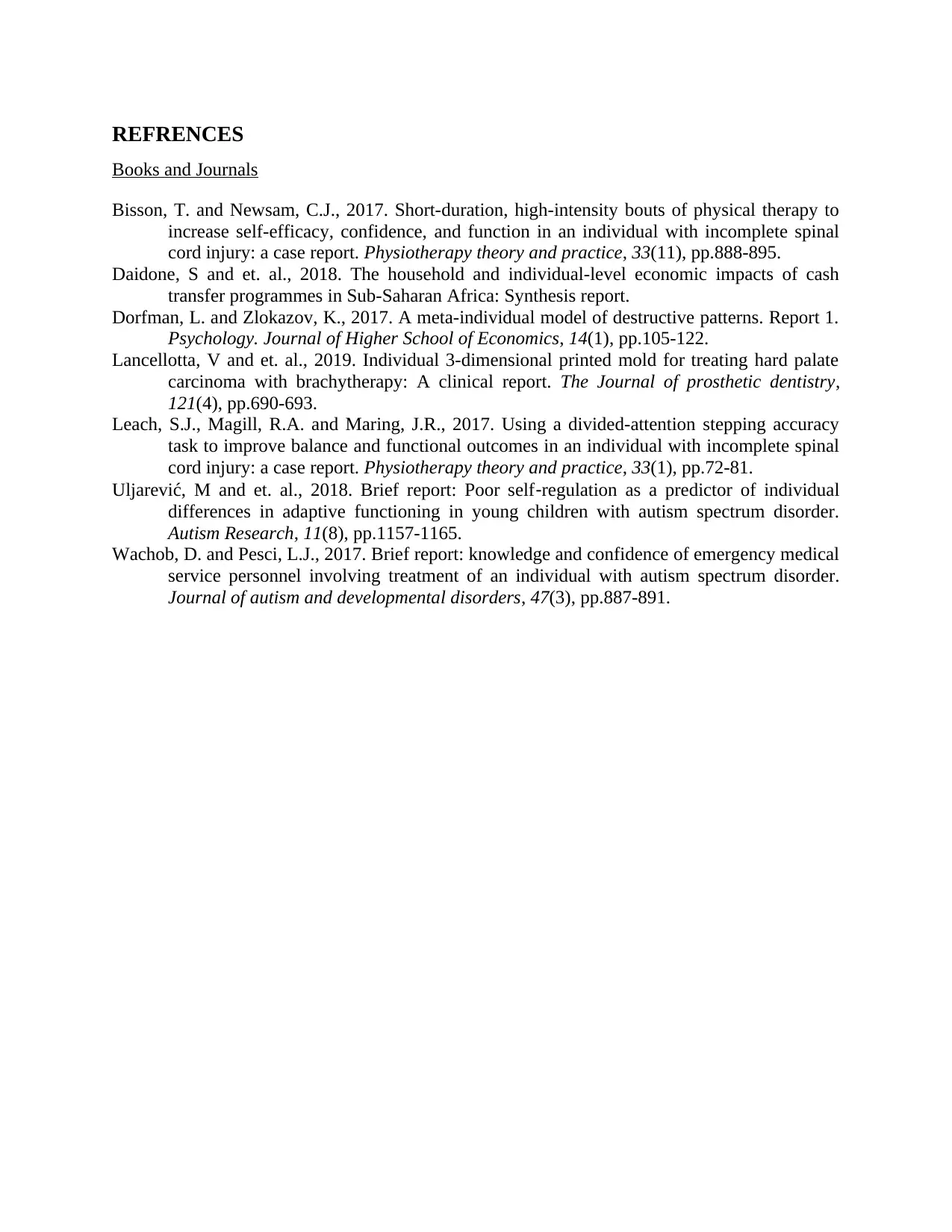
REFRENCES
Books and Journals
Bisson, T. and Newsam, C.J., 2017. Short-duration, high-intensity bouts of physical therapy to
increase self-efficacy, confidence, and function in an individual with incomplete spinal
cord injury: a case report. Physiotherapy theory and practice, 33(11), pp.888-895.
Daidone, S and et. al., 2018. The household and individual-level economic impacts of cash
transfer programmes in Sub-Saharan Africa: Synthesis report.
Dorfman, L. and Zlokazov, K., 2017. A meta-individual model of destructive patterns. Report 1.
Psychology. Journal of Higher School of Economics, 14(1), pp.105-122.
Lancellotta, V and et. al., 2019. Individual 3-dimensional printed mold for treating hard palate
carcinoma with brachytherapy: A clinical report. The Journal of prosthetic dentistry,
121(4), pp.690-693.
Leach, S.J., Magill, R.A. and Maring, J.R., 2017. Using a divided-attention stepping accuracy
task to improve balance and functional outcomes in an individual with incomplete spinal
cord injury: a case report. Physiotherapy theory and practice, 33(1), pp.72-81.
Uljarević, M and et. al., 2018. Brief report: Poor self‐regulation as a predictor of individual
differences in adaptive functioning in young children with autism spectrum disorder.
Autism Research, 11(8), pp.1157-1165.
Wachob, D. and Pesci, L.J., 2017. Brief report: knowledge and confidence of emergency medical
service personnel involving treatment of an individual with autism spectrum disorder.
Journal of autism and developmental disorders, 47(3), pp.887-891.
Books and Journals
Bisson, T. and Newsam, C.J., 2017. Short-duration, high-intensity bouts of physical therapy to
increase self-efficacy, confidence, and function in an individual with incomplete spinal
cord injury: a case report. Physiotherapy theory and practice, 33(11), pp.888-895.
Daidone, S and et. al., 2018. The household and individual-level economic impacts of cash
transfer programmes in Sub-Saharan Africa: Synthesis report.
Dorfman, L. and Zlokazov, K., 2017. A meta-individual model of destructive patterns. Report 1.
Psychology. Journal of Higher School of Economics, 14(1), pp.105-122.
Lancellotta, V and et. al., 2019. Individual 3-dimensional printed mold for treating hard palate
carcinoma with brachytherapy: A clinical report. The Journal of prosthetic dentistry,
121(4), pp.690-693.
Leach, S.J., Magill, R.A. and Maring, J.R., 2017. Using a divided-attention stepping accuracy
task to improve balance and functional outcomes in an individual with incomplete spinal
cord injury: a case report. Physiotherapy theory and practice, 33(1), pp.72-81.
Uljarević, M and et. al., 2018. Brief report: Poor self‐regulation as a predictor of individual
differences in adaptive functioning in young children with autism spectrum disorder.
Autism Research, 11(8), pp.1157-1165.
Wachob, D. and Pesci, L.J., 2017. Brief report: knowledge and confidence of emergency medical
service personnel involving treatment of an individual with autism spectrum disorder.
Journal of autism and developmental disorders, 47(3), pp.887-891.
⊘ This is a preview!⊘
Do you want full access?
Subscribe today to unlock all pages.

Trusted by 1+ million students worldwide
1 out of 9
Related Documents
Your All-in-One AI-Powered Toolkit for Academic Success.
+13062052269
info@desklib.com
Available 24*7 on WhatsApp / Email
![[object Object]](/_next/static/media/star-bottom.7253800d.svg)
Unlock your academic potential
Copyright © 2020–2025 A2Z Services. All Rights Reserved. Developed and managed by ZUCOL.





